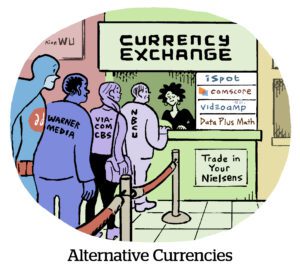We’ve all heard of ecommerce. But what about T-commerce?
Television commerce, or T-commerce, is similar to shoppable TV – both refer to buying something you see on television. But the two terms have their own nuances and, therefore, different implications for advertisers and publishers.
T-commerce has been around for decades and is the broader umbrella term for any action spurred by content viewed on a TV screen, from dialing the phone number in a cable commercial to scanning an onscreen QR code. Think QVC and infomercials.
But shoppable TV is far more nascent and has a narrower meaning. It refers to buying something directly from a TV screen using a remote control, such as (but not limited to) Roku and Fire TV remotes.
In short, if you buy something using your TV remote, that’s shoppable TV. But when you use another device to complete the purchase, such as a phone, that’s T-commerce, technically speaking.
Think of shoppable TV as a subset of T-commerce, said Steven Golus, a digital advertising consultant and founder of Steven Golus Consulting.
All shoppable TV is T-commerce, but not all T-commerce counts as “pure shoppable TV,” he said.
Who cares whether it’s T-commerce or shoppable TV?
The difference between T-commerce and shoppable TV is more than semantics.
These two purchase mechanisms require very different attribution models.
TV has a historic attribution problem because, well, people don’t typically buy things straight from their TV. They might learn about a product on television, but convert later on their laptop, desktop, mobile phone or in that old standby – the store. But without a direct click, no amount of data science in the world can determine whether a specific ad is what inspired a particular purchase.
QR codes help attribute sales and conversions but they’re still not a perfect solution.
Sometimes people scan QR codes for more information about a product with the intention to take action later. But if they don’t convert within the attribution window, their purchase won’t be attributed to the TV ad, even though it deserves credit for helping drive the transaction.
A segue into shoppable TV
Still, QR codes could help move shoppable TV forward.
Publishers like Roku, NBCUniversal and Disney are trying to make shoppable TV happen in part as a method for helping advertisers attribute sales to TV ads. All three have varying integrations with Walmart, which is also creating its own shoppable videos and would logically continue to do so if and when it closes its acquisition of Vizio.
The problem is, there’s not much evidence that shoppable TV– as in, buying stuff directly from TV ads – is gaining traction with consumers, Golus said. The tech that supports shoppable ad overlays for TV commercials is still young, and consumer adoption is quite slow.
Arguably, shoppable TV is antithetical to the nature of TV viewing, which is a lean-back experience during which people don’t want to be interrupted.
“If I’m watching the Super Bowl, I’m not going to stop and buy a pair of shorts,” Golus said.
It takes time – and seamless tech – to change consumer habits, which is why many publishers consider QR codes to be the first “leap” toward getting shoppable TV off the ground, he said.
According to Golus, the biggest opportunity for driving sales “initiated by the TV,” at least for now, still lies with T-commerce – and, more specifically, encouraging people to make purchases when they’re actually in the mood to shop. (Which, uh, may not be in the middle of watching their favorite movie.)
Disney, for example, launched a shoppable ad format from Hulu onto Disney+ during CES earlier this year that prompts viewers to click to send more info about a product to their email or cellphone. That way, rather than having to buy an item then and there, consumers can bookmark the information and revisit it later.
Industry experts agree this “save for later” approach is where a lot of innovation is happening among publishers with shoppable TV ambitions.
Just push play (erm, I mean, purchase)
The challenges of scaling “pure play” shoppable TV doesn’t mean it can’t happen. Change just takes time.
But publishers with access to real shopper data have the best chance of getting results, Golus said.
Now that Amazon has an ad tier for Prime Video, for example, it can tailor connected TV ads to consumers based on their purchase history on Amazon.com. Not only would these ads be relevant, Golus said, but Amazon could make it easy for viewers to click on their remote to add products to their Amazon carts. Prime Video still mostly uses QR codes to encourage purchases from TV commercials, but the potential is clear.
Walmart and Vizio have a similar data opportunity. Acquiring Vizio would give Walmart control over Vizio’s TV inventory and its automatic content recognition data. The retail giant could use this data to target ads for its products to viewers based on their purchase habits.
But speculation about fancy targeting aside, TV publishers hope that, as viewers grow accustomed to scanning QR codes on screens, they’ll in turn become more receptive to shopping straight from the TV itself – so long as it’s easy to do so, which isn’t always the case.
We’ll have to see how that journey goes.
Real people don’t care about the definition of terms like “shoppable TV” and “T-commerce” or about an advertiser’s ability to attribute sales – they care about the viewing experience. And if a new technology feels too disruptive or clunky, they won’t use it.















